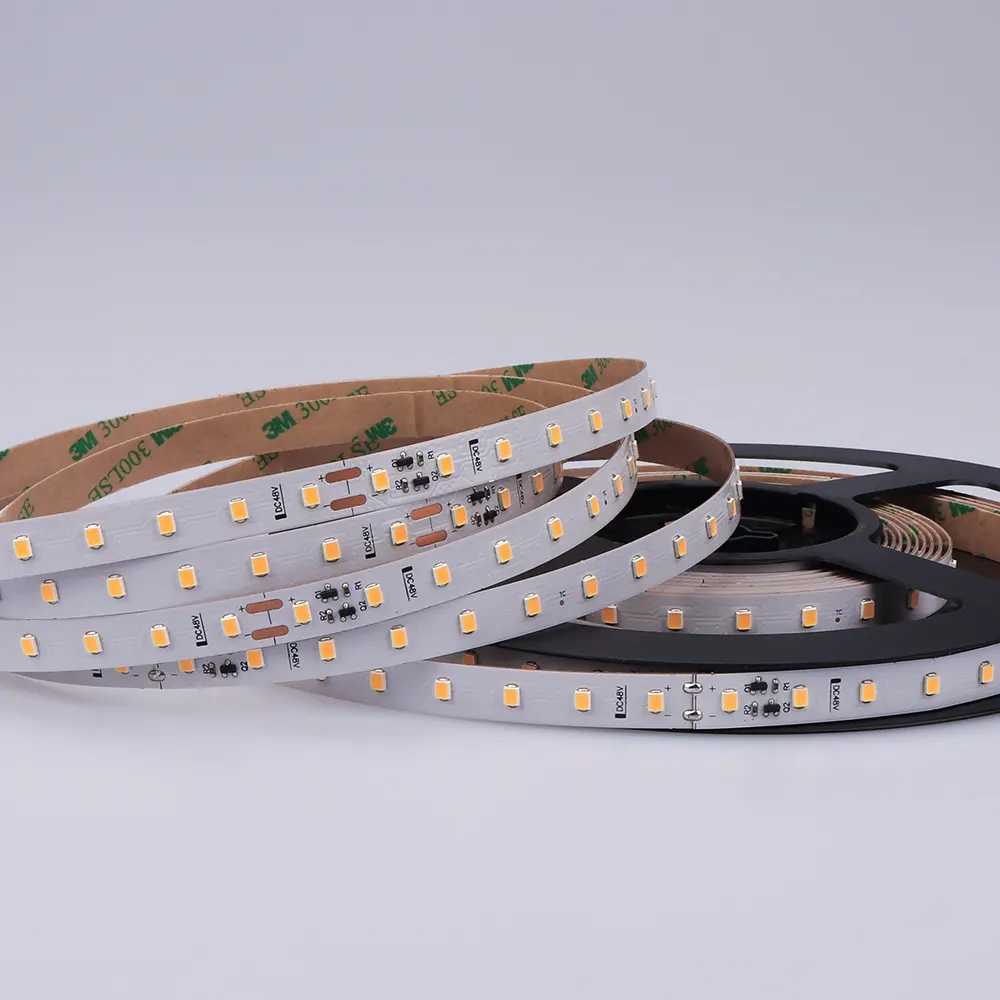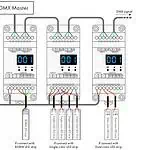Regarding LED strip length, 5 meters/reel is the most common size. But do you know LED strips can be as long as 60 meters/reel?
The LED strip length is measured in meters per reel. And the length of the LED strip depends on the voltage drop. Low-voltage LED strips like 12V or 24V are usually 5 meters in length. Whereas high-voltage AC LED strips with a voltage rating of 110V or 240V can go up to 50 meters in length. However, the longest LED strip available is 60 meters, providing constant brightness from end to end without any voltage drop.
In this article, we will explore different lengths of LED strips and learn about the longest LED strip length available. Here you will also know how voltage drop limits the LED length and how to increase the length of your LED strips. So, without any further delay, let’s begin-
What Is LED Strip Length?
LED strips are tape or rope-like flexible light fixtures that come in reels. And the length of the strip per reel is the LED strip length. However, you can cut these strips to your required size as they have cut points.
Usually, LED strips come in a 5m reel which is the standard size. And this 5m LED strip is available mainly in two voltages, 12V, and 24V. Besides, many other length options are available for LED strips; you can also customize the length as per your requirement. But, the fact to be noted is that the voltage will also have to be increased with the increase in length. But why so? Let’s find the answer in the below section.

How Does Voltage Relate To Strip Length?
When purchasing an LED strip, you will find the voltage rating written side by side in the specification. This is because the voltage is deeply related to the length of the strip. How? To know that, let’s get into some physics.
When the length of the strip increases, the resistance of current flow and the voltage drop also increase. So, to ensure proper current flow, the voltage also has to be increased with the increment of length. So, here you need to keep two factors in mind-
Length ⬆ Voltage ⬆ Voltage Drop ⬇
- The voltage of the strip has to be increased with the increase in length to minimize the voltage drop
- With the same length, a strip with a higher voltage is better; 5m@24V is more efficient than 5m@12V
In the later section of the article, you will also learn more about the concept of voltage drop and how it affects the strip length. So, continue reading.
Different LED Strip Lengths
As you already know, the length of the LED strip depends on the voltage. Here are some common LED strip lengths for different voltage ranges:
| Length Of The LED Strips | Voltage |
| 5-meter/reel | 12V/24V |
| 20-meter/reel | 24VDC |
| 30-meter/reel | 36VDC |
| 50-meter/reel | 48VDC & 48VAC/110VAC/120VAC/230VAC/240VAC |
| 60- meter/reel | 48V Constant Current |
Besides these lengths, LED strips are available in other measurements also. You can also customize the LED strip lengths as per your requirement.
LED Strip Length Based on Constant Voltage
The 5-meter length of the LED strip is the most common variant available on LED strips. With this length, you will get two options: a 12V direct current and a 24V direct current.
- 5 meters@12VDC Constant Voltage
A 5-meter, 12V LED strip usually has cut marks after every three LEDs. These are the most common types of LEDs used for indoor lighting. You can use them in your bedroom, living area, office room, and more.
- 5 meters@24VDC Constant Voltage
LED strips of 5-meter length with 24V rating are quite similar to that of the 12V in terms of light output. However, they have different cutting mark spacing compared to 12V. Usually, 24V LED strips come with cut marks after each 6 LED.
12VDC Vs. 24VDC: Which Is Better?
For 5-meters length, keeping the LED number constant, the lighting output will be the same for 12V and 24V. The only difference will be in the combination of voltage and amperage. For example- if it is a 24W/m LED strip, for 12V, it will draw 2.0A/m. In contrast, for 24V, the same 24W/m LED strip would draw 1.0A/m. But this amperage difference will not affect the light output. Both strips will provide equal lighting. Yet, due to less amperage draw, the 24V variant is more efficient. It will work better within the LED strip and also a power supply.
Besides, if you want to increase the length of the LED strips, 24V would be best. For example- you can connect two 5-meter LED strips using an LED strip connector and thus increase its length up to 10-meters. In this case, a 12V LED strip will have more voltage drop affecting the performance of the light. So, 24V can handle twice the load of the 12V variant.
Thus, 5-meter@24V is a better option than 5-meter@12V. But, in another sense, the 5-meter@12V gives you more flexibility in sizing. So, if sizing is an issue, you can also go for 12V.
For more information, you can read How to Choose The Voltage of LED Strip? 12V or 24V?

What is a Constant Current LED Strip?
Constant Current (CC) LED strips are long-run LED strip lights. These lights offer you a more extended length per reel without the issue of voltage drop. You only need to connect the power supply to one end, and the brightness of the light will be the same from end to end. From these strips, you can achieve the length of 50-meters, 30-meters, 20-meters, and 15-meters per reel.
Features:
- Stable current
- No voltage drop
- Same brightness
- Thicker PCBs, such as 3 ounces or 4 ounces
- Has constant current ICs on the PCB or ICs inside the LED
- Silicone integrated extrusion process, IP65, IP67 up to 50-meters per reel
- CRI>90 and 3 steps Macadam
Variants Available:
- Single color
- Warm white
- Tunable white
- RGB
- RGBW
- RGBTW
LED Strip Length Based on Constant Current
The constant current LED strips can be of the following lengths-
- 50meters@48VDC Constant Current
With a 48VDC rating, this 50-meter LED strip will have the same brightness from the start to the end. And the power needs to be connected only at one end.
- 30 meters@36VDC Constant Current
A constant current LED strip of 30-meters will require a voltage of 36VDC to ensure continuous brightness from end to end.
- 20 meters@24VDC Constant Current
20-meter LED strips with constant current are available at 24VDC. They will provide the same brightness from end to end. But 5-meter@24VDC constant voltage LED strips are also available. And joining four of those strips, you can make a 20-meter-long strip, so why go for 20-meter@24VDC constant current LED strips?
Extending the length of 5-meter@24VDC constant voltage will create voltage drop issues. So, to solve this problem, you will require to connect extra parallel wirings from the power supply to each new LED strip. This process will have to be repeated for each of the strips you add, which makes the circuit too complex and also kills your time. In contrast, using a 20-meter@24VDC constant current LED strip is straightforward—no need for extra wirings to keep the brightness constant.
Visit our LEDYi website to get premium quality constant current LED strips. Besides these above-discussed lengths, there are many more options available to us. To know more, check out Constant Current LED Strip.

What is an AC Driverless LED strip?
AC driverless LED strips are high-voltage LED strips. These are powered by alternating currents and don’t require any driver. For this reason, they are known as AC driverless LED strips.
Traditional high-voltage LED strips have a power supply plug to change AC to DC. But these AC driverless LED strips can operate without a driver. They have a diode rectifier on the PCB and do not need a power supply plug. Moreover, the cut unit length of these strips is only 10cm, which is much smaller compared to the 50cm or 100cm cut length of the traditional ones.
Features:
- No drivers or cumbersome transformers required
- Quick install, plug and play out of the box
- No wires to cut and solder
- Long run 50-meters with just one plug-In
- Shortcutting length, 10cm/Cut
- High-Grade PVC housing for added protection
- Injection-molded end cap and solder-free & glue-free endcap
- Build-in piezoresistor and safety fuse inside; anti-lightning protection
- Perfect for indoor or outdoor applications
Length Of AC Driverless LED strips
If you want long-length LED strips to install in AC, driverless LED strips are available in a single length, 50-meters. But there are four voltage options available. These are:
- 50 Meters@110V Driverless AC LED Strip
These 50-meter LED strips come with a voltage rating of 110V and can operate without any driver.
- 50 Meters@120V Driverless AC LED Strip
The function of these LED strips is the same as the 110V; only there is a slight difference in the voltage. However, these two are almost close and can’t be differentiated much. Yet, it uses less current to bring equal light output to 110V.
- 50 Meters@230V Driverless AC LED Strip
The 50-meter driverless AC LED strip with 230V is more efficient than the 110V and 120V. As the length is too long, going for these strips is more reliable as they are better at emitting the issue with voltage drop.
- 50 Meters@240V Driverless AC LED Strip
240V is the highest range for driverless AC LED strips of 50-meters. The performance of these LED strips is similar to that of 230V. But with the voltage increment, these strips become more efficient as they use less current.
These are excellent for applications where you need long-length strips. You can cover up to 50-meters with a single strip; no need to take the hassle of strip slicing and parallel wiring. Besides, these high-voltage strips provide smooth and even lighting. So, to get these high-voltage AC driverless LED strips, check out Driverless AC LED Strip Lights.

What are The Longest LED Strip Lights?
From the above section, you have already learned about different lengths of LED strips for various voltage ranges. These strip lengths were categorized based on constant voltage, constant current, and driverless AC strips. Now let’s know about the longest LED strip.
60 meters@48V Constant Current
60 meters@48V is the longest LED strip available. These super long LED strips supply constant current in the PCB that keeps equivalent brightness from end to end. Besides, there are no voltage drop issues with these strips. They are available in different variants and can be used for indoor and outdoor lighting. You can also get IP65 and IP67 ratings in these strips that ensure waterproofing. Here are the major features of 60-meter, 48V LED strips-
Features:
- Ultra Long; 60-meters
- Constant current IC on PCB; constant end-to-end brightness
- Thicker PCB; 3 oz or 4 oz
- No voltage drop problem
- 3M heat dissipation backing tape
- Driven by a single-end power supply
- Good heat dissipation function
- Less lighting degradation
- Pulse Width Modulation (PWM) dimming
- Fewer drivers
- High efficiency & lumen output; 2000lm/m
- Less wiring requirement
- Faster installation and less installation cost
- Longer lifetime
Variants Available:
- Single color
- tunable white
- RGB
- RGBW
Available IP Ratings:
- IP20 none waterproof
- IP65 silicone extrusion tube
- IP67 full silicone extrusion
If you want long-length LED strips to install in your lighting project, you can check this- 48V Super Long LED Strip. Our LEDYi LED strip of 60-meter length will provide you with all the features mentioned in this section. Besides, it also comes with a warranty of 3 – 5 years.

How Does Voltage Drop Limit The Length Of LED Strips?
The voltage loss experienced between the power source and the LEDs is known as LED strip voltage drop. It is mainly caused by the resistance of the conductor and the current passing through it.
Voltage Drop = Current x Resistance
The voltage in the LED strip’s DC circuit steadily drops as it travels through the wire and the light strip itself. This occurs because of the increase in resistance. So, the higher the resistance, the greater the voltage drop.
Resistance ⬆ Voltage Drop ⬆
When you increase the length of the LED strip, the resistance increases, and so does the voltage drop. As a result, one side of your strip lights will be brighter than the other due to the extension of the strip length. Thus, the length of the LED strip is limited by the voltage drop problem.
To solve this issue, you must increase the voltage rate as you increase the length. Because when you increase the voltage, the current will be lower, and the voltage drop will be smaller. Thus, it will ensure the same brightness throughout the strip. To learn about this concept, read this article: What is LED strip voltage drop?
How to Increase the Running Length of LED Strips?
Increasing the length of the LED strip is to reduce the voltage drop. Here are the ways you can reduce the voltage drop of the LED strip with the increase in length-
Reduce Power Consumption of LED Strips
The power consumption of an LED strip depends on the current flow and voltage of the LED strip. Here, the current flow is directly proportional to the power. According to Ohm’s law,
Power = Voltage x Current
So, as you decrease the power, the current flow is also decreased. And so the voltage drop reduces. For this reason, reducing the power consumption will lower the current flow and the voltage drop when you increase the running length. Thus, the brightness of the light will remain constant from end to end.
Use Higher Output Voltage
Voltage loss issues affect all low-voltage LED strips, such as 5VDC, 12VDC, and 24VDC. Because, for the same amount of power consumption, the current is higher at lower voltages. In contrast, higher voltage LED strips like- 110VAC, 220VAC, and 230VAC don’t have voltage drop issues. They have a maximum run distance of 50-meters for a single-end power supply. And as you increase the voltage, the current flow will decrease, reducing the voltage drop. For this reason, using higher output voltage is essential for increasing strip length.
Use Thicker and Wider PCB
In LED strips, PCB stands for Printed Circuit Board. It is also a conductor similar to wires and has its own resistance. Copper serves as the conductive material on a PCB. The longer the PCB, the higher the resistance. But with thicker and wider PCB, the resistance is reduced, and so is the voltage drop. That is why thicker and wider PCBs are used in high-voltage LED strips.
Therefore, following these factors, you can increase the length of the LED strip, keeping the glow of the LEDs perfect.

Benefit of Using Long-Run LED Strips
Long-run LED strips are excellent for installation when you have a large area to light. These are the benefits of using long-run LED strips-
- Easy wiring, saving installation costs
When you use small-length LED strips for large-area lighting, it requires multiple strip connections. The problem is that the voltage drop gradually increases when you join numerous strips. And so the brightness of the light decreases gradually as the current runs through the strip length. To solve this problem, each end of the strips requires parallel wiring to the power source. And this installation is very critical, so you need electricians’ help, which increases your cost.
In contrast, long-run LED strips do not need any joins. You can use these strips to cover up to 50-meters of the area with one end power supply. And with super long LEDs of LEDYi, this length can extend up to 60-meters! This not only makes your wiring easy but also saves your installation cost. You can simply plug one side of the strip into the power supply, and the work is done.
- No voltage drop issues, consistent brightness
The common problem with low-voltage LED strips like 12V or 24V is their voltage drop. So, when you increase the length, the voltage drop increases. This hampers the strip’s brightness, and even lighting is not produced across the strip length.
Meanwhile, the long-run LED strips have high voltage, so they don’t have voltage drop issues. Due to higher voltage rates, the current flow of these strips is lower. And so, the voltage drop is also minimal. That is why you will get consistent brightness from end to end by connecting one end of these strips to the power supply. Thus, the total 50-meters of the strip will glow with equal brightness.
FAQs
The LED strip has a definite length limit depending on the voltage. For example, a 12V LED strip can be 5-meters. And if you increase the length of this strip, it will face voltage drop issues. So, when the LED strip is too long, the voltage between the power source and the LED gradually drops as the current passes through the length. As a result, the brightness of the light gradually decreases from the starting to the ending point of the strip.
You can make the LED strips longer by joining numerous strips using LED strip connectors or soldering. But the problem is that connecting multiple strips causes a voltage drop, hampering the lighting. So, as you increase the length, you have to add parallel wiring connecting the end of each strip to the power source to reduce the voltage drop.
LED strips are installed directly into the walls removing the adhesive backing. So, the distance between the LED strip and the wall doesn’t matter here. However, when covering lighting with LED strips, you should keep at least 100 mm of space from the ceiling and 50mm from the wall.
Yes, long-run LED strips have cut marks, following which you can easily cut them. Besides, they have a minimal cutting space (10cm) that allows you flexible sizing.
The longest LED light available is 60-meters at a 48V constant current. These strips provide constant brightness without any voltage drop.
5m LED strips come in two different voltages- 12V and 24V. The increment of LED strip length depends on these voltage rates. A 12V LED strip loses its voltage as you connect more strips. Whereas a 24V LED strip can extend up to 10-meters, you can connect two of these 5-meter strips. However numerous LED strip connections are possible, but in this case, you need to add extra power supply units down the line.
The Bottom Line
To sum up, the length of the LED strip depends on voltage drop. When you increase the size of the LED strip, the resistance inside the strip increases, so the voltage drops. And due to voltage drop, the strip’s brightness is directly affected. That is why the voltage rate is increased with the length. Because as the voltage is increased, it reduces the voltage drop and keeps the brightness of the LED strip constant.
For precise planning and to avoid issues with voltage drop, we recommend using our Voltage Drop Calculator. This tool helps you calculate the expected voltage drop based on your setup, ensuring optimal performance and uniform lighting for your project.
However, if you want longer LED strips to light your project, go for LEDYi 48V Ultra-Long Constant Current LED strips. These strips have a length of 60-meters that can glow with a one-end power supply. What is more impressive is that they are highly efficient (2000lm/m) and durable. Besides, they come with a warranty of 3 -5 years. So, to install long LED strips without the hassle of wiring and cutting, contact us soon!







